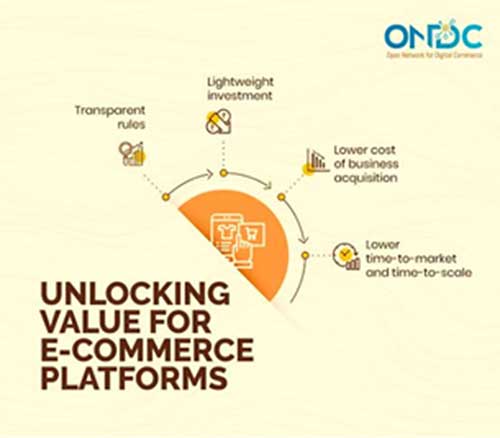Date : 10/06/2023
Relevance - GS Paper- 3 - Science and technology - Latest technological development
Key Words – ONDC, e- commerce, UPI
Context–
The Union government is looking to formally launch the Open Network for Digital Commerce (ONDC) this year to “democratise e-commerce” and “to provide alternatives to proprietary e-commerce sites”. While it has urged companies to join the ONDC platform, major e-commerce players such as Amazon and Flipkart have been reluctant to get on board.
What is the ONDC?
The government wants to change the fundamental structure of the e-commerce market from the current “platform-centric model to an open-network model”. The ONDC is modelled after the Unified Payments Interface (UPI) project that is seen as a success by many. The UPI project allows people to send or receive money irrespective of the payments platforms on which they are registered. Similarly, the government wants to ensure that buyers and sellers of goods in the e-commerce market can transact regardless of the platforms on which they are registered. So under ONDC, a buyer registered on Amazon, for example, may directly purchase goods from a seller who sells on Flipkart. To make such transactions a reality, the government has ordered companies to list themselves on the ONDC. The pilot version of ONDC was launched last year in a few major cities and thousands of sellers have already been on-boarded onto the platform. Amazon and Flipkart, however, have not on-boarded their main shopping platforms onto the ONDC network yet.
Why is the Government pushing for it?
The government believes that the ONDC will put an end to the domination of the e-commerce market by a few large platforms. It says that the e-commerce market is currently broken into “silos” operated and dominated by private platforms. Amazon and Flipkart, for instance, have been accused of promoting certain seller entities in which they hold indirect stakes. Food delivery apps such as Swiggy and Zomato have also been accused of charging high commissions from sellers. With an open network like ONDC that connects buyers and sellers across platforms, the government hopes to level the playing field and make private platforms redundant.
What do critics say?
Critics argue that the purported benefits of an open network for digital commerce are far from certain at the moment. For one, sellers are already free to list their products across various e-commerce platforms even in today’s platform-centric e-commerce model. Buyers also routinely shop across platforms. Then there are also services such as price-comparison that are offered by various private websites that bridge the information gap and help buyers make better decisions. So, critics argue, the domination of the e-commerce market by platforms such as Amazon and Flipkart may not be due to any captive hold that these platforms have over buyers and sellers. Further, the supposed monopoly that platforms are said to enjoy may be no different from the limited monopoly that any business today has over its property.
The way forward
The capacity of the government’s technocrats to come up with an efficient alternative to e-commerce platforms that can work seamlessly will be tested as the government rolls out the ONDC. It remains to be seen if and how the government’s open network will list products offered by various sellers. Competition generally pushes e-commerce platforms to prominently list products that are most likely to catch the fancy of buyers. Their on-boarding and listing of sellers is also heavily influenced by the ability of sellers to fulfil customer orders. In fact, platforms may invest money to build exclusive on-boarding and listing processes. If the open network’s rules prevent platforms from benefiting from such investments, they may cease to make them anymore. This will eventually affect the quality of services available to consumers. Building an efficient marketplace for the sale of goods and services may turn out to be the key challenge for ONDC.
Probable Questions for Mains Exam -
- Question 1 – What do you understand by ONDC? How it would pave the way for a more substainable e- commerce? (10 Marks, 150 Words)
- Question 2 – Why is the Government trying to explore ONDC model for e- commerce companies? Analyse the pros and Cons of its implemention? (15 Marks, 250 Words)
Source – Forbs India







